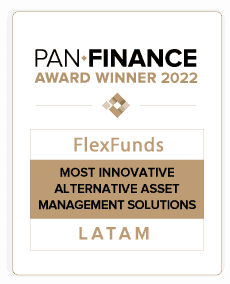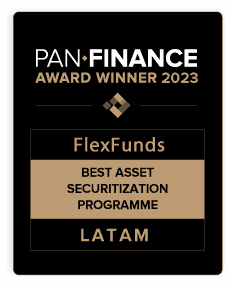- Throughout the article, you will find information on the main barriers and challenges for the financial sector in an increasingly competitive market. Learn the opinions of nearly a hundred asset managers in the First Annual Report of the Asset Securitization Sector, prepared by FlexFunds. Download it here!
- The information in the article is useful for portfolio managers wishing to delve into one of the sector’s biggest and ongoing challenges: customer acquisition.
- FlexFunds offers managers the ability to design and launch custom investment vehicles cost-effectively, facilitating capital acquisition in international markets.
Capital acquisition and, consequently, customer acquisition are among the most significant challenges the financial sector has to face. Regardless of the economic situation, portfolio management is an activity that operates in a slippery terrain where managers share the same objective.
Even though both parties pursue the same goals, market instability, lack of understanding, investor fear, changes in economic conditions, or low profitability make portfolio management an intensely demanding activity.
The First Annual Report of the Asset Securitization Sector prepared by FlexFunds outlines some of the challenges that will be most relevant in 2024 for customer acquisition based on a survey of nearly a hundred industry experts.

Figure 1: Challenges in client acquisition and capital raising. Source: First Annual Report of the Asset Securitization Sector by FlexFunds
Market uncertainty
The absence of stability and predictability in the market is (and always has been) the main enemy of investment. The last 12 months have been marked by various geopolitical and economic events, such as the Ukraine war, the energy crisis, persistent inflation, and interest rate hikes promoted by central banks.
In the context of interest rate hikes starting in 2022, with several geopolitical crises and a tense international environment, doubts, uncertainty, and a sense of lack of control grip investors.
In this climate, high market volatility erodes overall confidence and tranquility. According to the report, nearly 7 out of 10 professionals consider uncertainty to be the main challenge for capital and customer acquisition.
Lack of liquidity
The surveyed experts point to a lack of liquidity as a second challenge hindering capital acquisition in the financial sector.
Fifteen percent consider money scarcity a clear difficulty in attracting funds. While we come from a period of market inundation, a contractionary monetary policy and the draining of family savings after the pandemic are taking away a significant portion of that liquidity.
One advantage of asset securitization is precisely to increase liquidity and access to alternative sources of financing.
Fear and insecurity in the financial system
On the other hand, fear, insecurity, and lack of trust in the financial system are other investment impediments that make customer acquisition challenging for entities and management firms.
In many cases, this fear is a product of ignorance, so personalized client monitoring and detailed explanations of their investments are challenges for every portfolio manager.
Undoubtedly, the relatively recent global financial crisis in 2008 or the banking crisis generated in the U.S. in 2023 have raised alarms and doubts about the advisability of staying in the markets.
High competition and low profitability
Another challenge the sector faces is the high competition that undermines profits in an environment where, with little product differentiation, attracting capital is very difficult.
Moreover, the difficulty in achieving high returns in certain markets, mentioned by 1% of respondents, hinders meeting investment expectations.
Key challenges in portfolio management
Among the most pressing challenges for portfolio management, the report highlights client risk tolerance, as “finding the right balance and ensuring that the portfolio aligns with the client’s risk tolerance is a significant challenge.”
Secondly, volatility, which can affect the portfolio’s value and require frequent adjustments to maintain balance and client objectives.
Also, economic and market conditions changes can impact asset profitability, requiring managers to adapt quickly and effectively.
Furthermore, diversification is key, but identifying optimal asset combinations and balancing the portfolio can be challenging, as is asset selection and active management, which requires constant monitoring and informed decision-making.
On the other hand, a constant challenge is management cost, which can affect the client’s net performance, so attention must be paid to balancing costs with the quality of services.
Finally, one of the most complex challenges in portfolio management is client emotional management during periods of volatility or low performance, as well as justifying returns and fitting them into expectations.
In this regard, and as a consequence, maintaining clear and effective communication with the client is essential to understanding their needs, explaining investment decisions, and ensuring trust over time.
Of course, compliance with various regulations and ethical standards in the financial industry is a constant challenge.
The study points out that the main challenges in managing the client portfolio are reporting (37.4%), Back-office (20.9%), Front-office (17.6%), accounting process (11%), and Middle-office (7.7%).
The report highlights that the client reporting process entails significant difficulties, such as the complexity of its financial information, which is challenging for clients to understand.
Solutions in response to portfolio management challenges
For more than half of the sample, facilitating investor onboarding, automatic and/or outsourced net asset value calculation and reporting, and centralized account management are the main needs.
Often, valuing portfolio assets can be a great challenge for managers, especially for less liquid and/or more complex assets. Real-time monitoring, high volatility, and lack of liquidity only complicate the process.
Therefore, incorporating new technologies and having processes and tools for centralized account management are winning bets and solutions that set the course for portfolio management and capital acquisition.
New technologies can facilitate the onboarding process, including a simplified online registration process with all the guarantees but avoiding lengthy and complex traditional forms.
Centralized account management can dilute the time cost due to economies of scale that can be generated, and the calculation and reporting of NAV more efficiently and faster can also improve portfolio management activity.
If you have any questions, you can contact one of our financial experts to make your inquiry.







